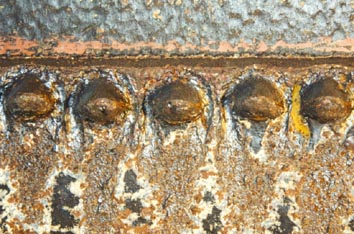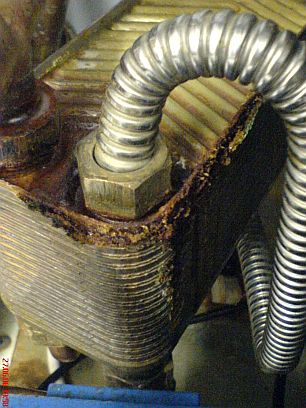Corrosion
Content |

|
1. What will you find here?
The range of different metals brought in contact when systems are built is extremely diverse. They are exposed over decades to humidity and more or less aggressive water. What occurs?There is no need to read and understand the DIN 50900 to prevent damage from corrosion right from the start by paying attention to some basic principles. As a starter to learning some useful information about heating and sanitary systems we refer you to some important paragraphs from an article by Heinz Körfgen written in 2001. [ contents ]
2. What causes corrosion
Corrosion is caused by a number of different factors interacting, i.e. water, metal and metal surfaces coupled with different operation and installation conditions.DIN 1988 enumerates some impacting factors and also defines how to design your system with adequate protection against corrosion. This rule of flow is given:
|
"In the direction of flow, water-carrying components and fixtures made of copper may not be fitted in front of components and fixtures made of zinc-plated iron in a drinking-water system (see DIN 50930 part 3).
Exceptions are tin-plated and nickel-plated copper components" |
In particular, electro-chemical corrosion arises from the formation of electro-chemical elements, i.e. locally limited elements, when two metals of different electro-chemical solution pressure come into contact.
Solution pressure results from the electrochemical series:
| Li, K, Ca, Ba, Na, Mg, Al, Zn, Fe, Cd, Ni, Sn, P, (H), Cu, Hg, Ag. |
The table shows the metals in increasing order of nobility, from left to right. A less noble metal knocks a more noble metal out of its solution.
Result: Pitting corrosion.
- Always install a high-grade filter just behind the water meter. Make sure to change the filter at regular intervals. The filter prevents particle deposits in horizontal pipes and thus the formation of grains leading to pitting corrosion.
3. Water
The
The risk of corrosion can be determined from the relationship between the separate elements. One way of expressing this relationship is the Corrosion Index S1. It is determined from
concentration of chlorine ions + concentration of sulphate ions
---------------------------------------------------------------
acid capacity KS4.3 (up to pH 4.3)
Carbonate hardness buffers the acid in a better way, i.e. soft water provides less resitance against lower pH-values or more acidic water - in addition to a weak protective coating.S1-values lower than 1.0 aree seen as harmless - above 1.0 the risk of pitting is higher and from 3.0 and above it will be expensive in the long run if nothing is done. [ contents ]
4. Metals and metal surfaces
Example iron pipe: If the hardness of the water is above the minimum of 40ºdH, (one degree German corresponds to one part calcium oxide in 100,000 parts of water) protective coating may form, provided that there is no high salt content, especially chloride, in the water. To make sure you get a protective coating, you should try to have a minimum hardness of 8ºdH and avoid a level of carbonic acid which will hinder the formation of anti-corrosion layer.Zinc-plated iron pipes have the advantage of electrochemical protection provided by the zinc. At higher temperatures (~70ºC) zinc is electrochemically more noble than iron. If damage to the zinc-plating and higher temperatures occur, iron becomes anodic in relation to zinc and iron corrodes quickly (pitting). If the water contains traces of copper compounds, corrosion will already begin at temperatures higher than 50░C. Thus: Zinc-plated iron pipes are generally not suitable for hot water pipes.
Copper pipes on the other hand have proved especially suitable for hot water piping because this material is semi-noble. A very thin protective CuO coating is formed in water which contains oxygen. Water which is medium to very hard forms a patina green coating. Soft water, water containing carbonic acid or cold tap water almost entirely prevents the formation of protective coating. Tap water containing a high level of alkali chlorides may lead to pitting.
Pitting will occur sooner if inappropriate welding material is used, or if welding grease which has entered the pipes, or if the pipes are subject to stress and strain due to cold bending.
Lead pipes corrode when the hardness of tap water is less than 8ºdH. Lead pipes are not suitable for hot water. [ contents ]
5. Off-gas tubes
Stainless steel pipes are no guarantee for a long service life: heat, condensation, sulphur and sulphur oxides, the chimney sweep's brush: all contribute to a shorter life for your pipes.Below, the off-gas temperature reaches 200ºC, while at the top, the flow may cool down by 70K ore more. At temperatures below dew point, the result is condensation, with wetness spreading through the whole pipe from the top down. (The dew point in off-gas is not the same as for pure air.)
Burning wheat will add undesirable products like
When
Watch out!
If your chimney is fitted with a corrosion-proof tube, just a single up and down with the sweep's wire brush will pit the tube, leading to contact corrosion and necessary replacement of the tube within 2 years.German sweeps are not liable for
An optimum solution, simultaneously providing noise reduction, is to use a Technaflon pipe. It is so smooth that particles deposited on the wall are washed off by the condensation.
The best thing is to upgrade your system with this pipe to an air/off-gas system. This gives you the advantage of using the calorific value effect!
The chimney sweeps in Germany continue to attack on this front: ignoring the manufacturers' advice, they go on using their brushes to scratch the surfaces of the pipes, leaving them damaged, rather than rinsing them, which is all that's necessary. They fail to learn the lessons of professional pipe cleaners... [ Inhalt ]
6. Heating water
When you fill your heating system with tap water, the pH-value is 5 to 7, the water in the heating system changes:- The hardness introduced in the form of calcium and magnesium is degraded to lime (scale) and carbon dioxide.
- The oxygen introduced is degraded to hydrogen and ferric oxide (acid attack).
- In an iron/mixed installation the best thing is to maintain the pH value between 8.5 and 10.5.
- In an aluminium/mixed installation the best thing is to maintain the pH value between 6.5 and 7.5.
Plastics and low-temperature heating systems cause more problems:

When underfloor heating from around the years 1980 do not include a twin-circuit system, the plate-type heat exchangers (PHE) become blocked and rust eats through everywhere. Blocking of valves will occur and disturb the hydraulic balance. (The system shown above was only one year old.)[Photo: R.N.] |
|